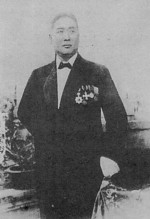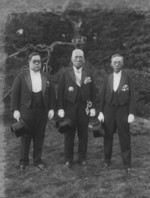![Koo Hsien-Jung file photo [21727] Koo Hsien-Jung file photo [21727]](/images/person_koo1.jpg)
Koo Hsien-Jung
| Surname | Koo |
| Given Name | Hsien-Jung |
| Born | 2 Feb 1866 |
| Died | 9 Dec 1937 |
| Country | Taiwan, Japan |
| Category | Government |
| Gender | Male |
Contributor: C. Peter Chen
ww2dbaseKoo Hsien-Jung (Pinyin romanization: Gu Xianrong) was born in Lu Gang, Zhanghua (Postal Map romanization: Changhua) County, Taiwan, Qing Dynasty China in Feb 1866. His father, Gu Qinzhang, a first generation immigrant from Fujian Province on the mainland, passed away when he was young, thus he was brought up by his mother. He moved to Taipei as a teenager, earning a living as a rickshaw runner and as a laborer. Very shortly after, he opened a small business transporting sugar between Taiwan, Shanghai, and Nanjing in mainland China. In 1892, he began selling coal mined in Keelung in northern Taiwan to buyers in Shanghai and Ningbo. In 1895, when Japanese troops landed on Taiwan, he guided Japanese troops from Keelung to Taipei, thus starting his collaborationist career. In Aug 1895, as Ko Ken'ei, which was the Japanese pronunciation of his Chinese name, he served as a local guide for Prince Yoshihisa of Kitashirakawa's guard division during its campaign to wipe out resistance fighters. For his assistance, he was invited to Tokyo, Japan, where he was awarded. In 1897, he was made an official in the occupation administration of Taipei. In 1900, he was given the monopoly over salt and camphor. In 1904, when the Russo-Japanese War began, he assembled a squadron of 12 his own merchant ships and personally commanded the squadron in patrolling the Taiwan Strait and the Luzon Strait; for this effort, he was awarded the Order of the Rising Sun, 5th Class in 1906. In 1909, he was transferred to Taichu Prefecture in central Taiwan, and was given monopoly over opium. In 1914, he was given monopoly over tobacco. In 1915, he was invited by Emperor Taisho to visit Japan; during the trip he was awarded Order of the Sacred Treasure, 4th Class. In 1918, his sugar business began to grow exponentially, leading him to establish a larger company, Yamato Sugar, in 1920 and then buying out Showa Sugar in 1921. Also in 1921, he took on a position in the office of the Japanese Governor General of Taiwan. In 1923, for his work during Prince Hirohito's tour of Taiwan, he was awarded Order of the Sacred Treasure, 3rd Class. Throughout the occupation, he played direct roles in further Japanese campaigns against Taiwanese resistance groups; many of these campaigns resulted in many deaths. In 1934, he became the first Taiwanese to be appointed by Emperor Showa to the House of Peers of Japan. In 1935, he traveled to China to meet with Chiang Kaishek in an attempt to improve China-Japan relations. He had six wives and concubines, who gave collectively birth to eight sons and four daughters. Koo passed away in Tokyo in Dec 1937. His remains were transported back to Shoka (Zhanghua) for burial. Because he passed away before the end of WW2, his sons largely bore the weight of the father's collaborationist past. Nevertheless, the businesses established by Koo became the foundation of the KGI financial and industrial conglomerate today.
ww2dbaseSource: Wikipedia
Last Major Revision: Oct 2014
Photographs
 |  |
Koo Hsien-Jung Timeline
| 2 Feb 1866 | Koo Hsien-Jung was born in Lu Gang, Zhanghua County, Taiwan, Qing Dynasty China. |
| 6 Jun 1895 | Koo Hsien-Jung led Japanese troops into the city gates of Taipei, Taiwan. |
| 9 Dec 1937 | Koo Hsien-Jung passed away in Tokyo, Japan. |
Você gostou deste artigo ou achou este artigo útil? Se sim, considere nos apoiar no Patreon. Mesmo USD $1 por mês já vai longe! Obrigado. Por favor, ajude-nos a espalhar a palavra: Fique atualizado com WW2DB: |
- » Wreck of M-49 Found (10 Apr 2025)
- » Japanese Emperor Visited Iwoto (Iwo Jima) (8 Apr 2025)
- » Race, Holocaust, and African-American WW2 Histories Removed from the US Naval Academy Library (7 Apr 2025)
- » US Government Plans to Purge WW2 Information (17 Mar 2025)
- » Ver todas as notícias
- » 1,167 biographies
- » 337 events
- » 44,606 timeline entries
- » 1,243 ships
- » 350 aircraft models
- » 207 vehicle models
- » 376 weapon models
- » 123 historical documents
- » 261 facilities
- » 470 book reviews
- » 28,505 photos
- » 365 maps
General Douglas MacArthur at Leyte, 17 Oct 1944
Por favor, considere nos apoiar no Patreon. Mesmo R$1 por mês já faz uma grande diferença. Obrigado!
Ou, por favor, nos apoie adquirindo alguns produtos do WW2DB na TeeSpring. Obrigado!